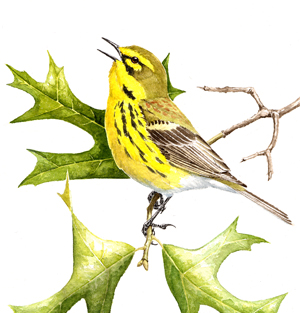Breeding Bird Atlases (BBA)
Find a Bird
Prairie Warbler
Dendroica discolor

Fairly widespread and likely increasing
Action/monitoring needed
State Wildlife Action Plan listed
“I was born on the prairies where the wind blew free and there was nothing to break the light of the sun. I was born where there were no enclosures.” – Geronimo
Natives of more western states than Massachusetts might scoff at the scrubby clearings that we Easterners call “prairies,” but such areas provide perfect habitat for the Prairie Warbler. This species abhors forests, and breeds in shrubby clearings and only the most open woodlands. Both human-caused and natural disturbances have created plenty of Prairie Warbler breeding habitat in the Commonwealth over the past several centuries. As forests reassert themselves, Prairie Warblers stand to lose habitat as a result of this natural succession.
Historic Status
The status of the Prairie Warbler as a breeding species in Massachusetts will forever be tied to the efforts of man. The Prairie Warbler has always been dependent upon that transition zone between forest and grassland, areas that today are called early successional or shrubland habitats and, as such, undoubtedly flourished in the early years of European settlement. Habitat change literally drives the distribution of this species. Nuttall observed Prairie Warblers near Mount Auburn in the 1830s, but by the time Brewster went looking for them at that same locale thirty years later, the birds were gone (Brewster 1906). Frank Chapman stated that while the species was widespread from the Gulf of Mexico to Massachusetts, because of its specific habitat needs, “even as a migrant, it is entirely wanting over large areas,” (Chapman 1907). Reforestation of the state during the twentieth century slowly began to squeeze the Prairie Warbler out of many Massachusetts locations.
Atlas 1 Distribution
The distribution of the Prairie Warbler in Atlas 1 was fairly lopsided toward the eastern regions, and overall the species was found in 38% of the blocks surveyed. The western and central ecoregions accounted for only 29% of the species range. A notable exception was the small Vermont Piedmont ecoregion, where Prairie Warblers were present in 7 out of 17 blocks. The Connecticut River Valley reported almost two dozen blocks with breeding Prairie Warblers, and the Lower Worcester Plateau had 54% block occupancy. Prairie Warbler distribution hit stride in the Coastal Plains, and the sandy Scrub Oak barrens of the Bristol/Narragansett Lowlands and the Cape and Islands had some of the highest concentrations in the state.
Atlas 2 Distribution and Change
Because they require what is usually an ephemeral habitat for breeding, Prairie Warblers are generally not reliably persistent in any one area, appearing and disappearing across the state as the landscape shifts. Their footprint increased overall to 46% of the blocks surveyed in Atlas 2, and the effort-controlled data showed an increase of 5%. The Berkshire Highlands and had net gains in Prairie Warbler distribution, and the sandplain grasslands of the Vermont Piedmont remained a small yet persistent haven for the species. The central lowlands in the Connecticut River Valley as well as the Worcester Plateau and Lower Worcester Plateau also gained many Prairie Warbler blocks. The species fared less well where it ran up against the Boston sprawl frontier in the Coastal Plains. Prairie Warblers appeared new in 53 blocks but vanished from 44, indicating plenty of movement within the region. All other eastern regions showed net losses of Prairie Warblers, though none more so than the Cape and Islands, where they disappeared from 26 blocks, but colonized only 16 blocks.
Atlas 1 Map

Atlas 2 Map

Atlas Change Map

Ecoregion Data
Atlas 1 | Atlas 2 | Change | ||||||
Ecoregion | # Blocks | % Blocks | % of Range | # Blocks | % Blocks | % of Range | Change in # Blocks | Change in % Blocks |
Taconic Mountains | 1 | 6.3 | 0.3 | 1 | 4.0 | 0.2 | 0 | 0.0 |
Marble Valleys/Housatonic Valley | 4 | 10.3 | 1.1 | 3 | 7.7 | 0.6 | -1 | -2.6 |
Berkshire Highlands | 2 | 3.6 | 0.5 | 15 | 27.3 | 3.1 | 11 | 20.8 |
Lower Berkshire Hills | 1 | 3.6 | 0.3 | 2 | 6.5 | 0.4 | 1 | 3.7 |
Vermont Piedmont | 7 | 41.2 | 1.9 | 10 | 58.8 | 2.1 | 2 | 16.7 |
Berkshire Transition | 10 | 26.3 | 2.7 | 10 | 25.0 | 2.1 | -2 | -6.5 |
Connecticut River Valley | 23 | 41.1 | 6.3 | 43 | 66.2 | 9.0 | 12 | 25.0 |
Worcester Plateau | 17 | 21.8 | 4.6 | 59 | 67.0 | 12.3 | 17 | 35.4 |
Lower Worcester Plateau | 40 | 54.1 | 10.9 | 54 | 67.5 | 11.3 | 10 | 18.5 |
S. New England Coastal Plains and Hills | 124 | 45.9 | 33.7 | 150 | 53.0 | 31.3 | 9 | 4.0 |
Boston Basin | 15 | 26.8 | 4.1 | 12 | 21.4 | 2.5 | -3 | -5.5 |
Bristol and Narragansett Lowlands | 53 | 50.0 | 14.4 | 50 | 43.9 | 10.4 | -3 | -3.0 |
Cape Cod and Islands | 71 | 52.2 | 19.3 | 70 | 48.6 | 14.6 | -10 | -8.3 |
Statewide Total | 368 | 38.0 | 100.0 | 479 | 46.2 | 100.0 | 43 | 5.2 |
Notes
The Breeding Bird Survey (BBS) shows significant declines in the Prairie Warbler’s abundance for Massachusetts, the New England/Mid-Atlantic Region, and the Eastern US overall. They fall into our “whispering bird” category – those species with a demonstrated stable or increasing breeding footprint from Atlas 2 data, but also a demonstrated decline in abundance from the BBS. This drives our final assessment that this is a species with a need for further monitoring and conservation action.



